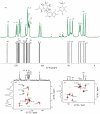Organic NMR crystallography: enabling progress for applications to pharmaceuticals and plant cell walls
- PMID: 39600178
- PMCID: PMC11599944
- DOI: 10.1039/d4fd00088a
Organic NMR crystallography: enabling progress for applications to pharmaceuticals and plant cell walls
Abstract
The application of NMR crystallography to organic molecules is exemplified by two case studies. For the tosylate salt of the active pharmaceutical ingredient, Ritlectinib, solid-state NMR spectra are presented at a 1H Larmor frequency of 1 GHz and a magic-angle spinning (MAS) frequency of 60 kHz. Specifically, 14N-1H heteronuclear multiple-quantum coherence (HMQC) and 1H-1H double-quantum (DQ) single-quantum (SQ) correlation experiments are powerful probes of hydrogen bonding interactions. A full assignment of the 1H, 13C and 14N/15N chemical shifts is achieved using also 1H-13C cross polarization (CP) HETCOR spectra together with gauge-including projector augmented wave (GIPAW) DFT calculation for the geometry-optimised X-ray diffraction crystal structure that is reported here (CCDC 2352028). In addition, GIPAW calculations are presented for the 13C chemical shifts in the two polymorphs of cellulose for which diffraction structures are available. For both case studies, a focus is on the discrepancy between experiment and GIPAW calculation.
Conflict of interest statement
Some of the authors are employees of Pfizer, and compound 1 is a Pfizer pharmaceutical.
Figures






Similar articles
-
Discovering the Solid-State Secrets of Lorlatinib by NMR Crystallography: To Hydrogen Bond or not to Hydrogen Bond.J Pharm Sci. 2023 Jul;112(7):1915-1928. doi: 10.1016/j.xphs.2023.02.022. Epub 2023 Mar 2. J Pharm Sci. 2023. PMID: 36868358
-
5-amino-2-methylpyridinium hydrogen fumarate: An XRD and NMR crystallography analysis.Magn Reson Chem. 2020 Nov;58(11):1026-1035. doi: 10.1002/mrc.5021. Epub 2020 Mar 29. Magn Reson Chem. 2020. PMID: 32187751
-
Investigating discrepancies between experimental solid-state NMR and GIPAW calculation: NC-N 13C and OH⋯O 1H chemical shifts in pyridinium fumarates and their cocrystals.Solid State Nucl Magn Reson. 2020 Aug;108:101662. doi: 10.1016/j.ssnmr.2020.101662. Epub 2020 Apr 10. Solid State Nucl Magn Reson. 2020. PMID: 32590237
-
Applications of high-resolution 1H solid-state NMR.Solid State Nucl Magn Reson. 2012 Feb;41:1-27. doi: 10.1016/j.ssnmr.2011.11.006. Epub 2011 Dec 2. Solid State Nucl Magn Reson. 2012. PMID: 22177472 Review.
-
Applications of solid-state NMR to pharmaceutical polymorphism and related matters.J Pharm Pharmacol. 2007 Feb;59(2):225-39. doi: 10.1211/jpp.59.2.0009. J Pharm Pharmacol. 2007. PMID: 17270076 Review.
Cited by
-
Spiers Memorial Lecture: NMR crystallography.Faraday Discuss. 2025 Jan 8;255(0):9-45. doi: 10.1039/d4fd00151f. Faraday Discuss. 2025. PMID: 39405130 Free PMC article.
References
MeSH terms
Substances
LinkOut - more resources
Full Text Sources
Miscellaneous

